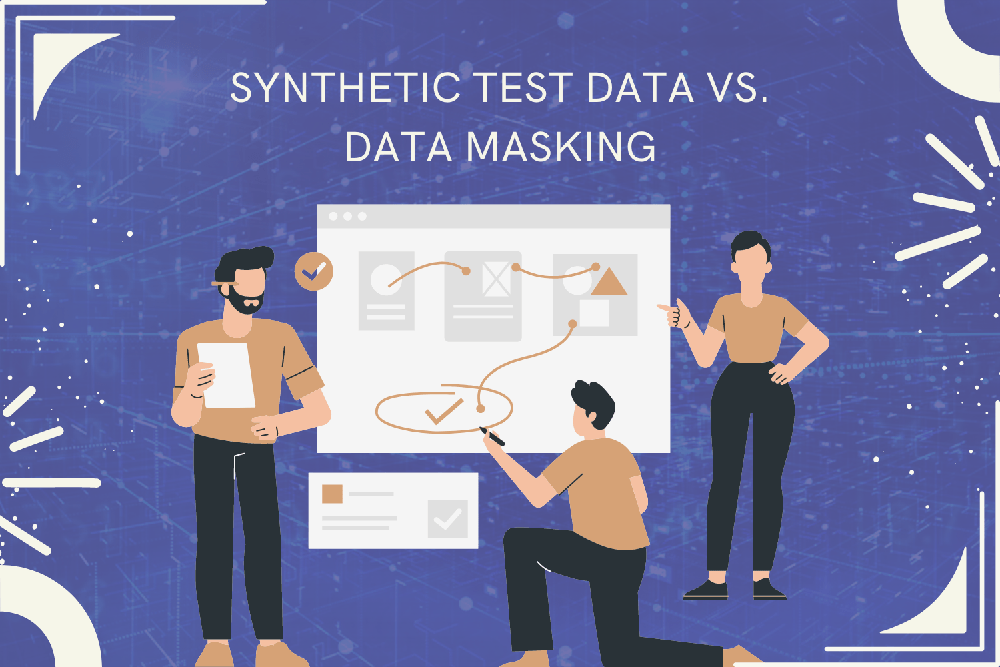Using actual production data in a test environment was once a no-brainer for most engineers. However, in the aftermath of privacy legislation such as GDPR, it is simply no longer an option. You can’t take those kinds of risks with actual people’s data – and if you do, you’ll be in a lot of trouble. A lot of costly problems. There are two basic solutions to this problem: data masking and the creation of synthetic data. Let’s look at how they function, what the distinctions are, and when you would want to employ each one. In this article, we will look at Synthetic Test data Vs. Data Masking.
What is Data Masking?
Data masking is substituting sections of secret or sensitive data with other forms of information, making it more difficult to identify the true data or persons to whom it is linked. The word referred to a variety of techniques, including anonymization, obfuscation, and pseudonymization.
Masking data can take numerous forms. For example, you may substitute various characters or symbols for names and personally identifiable data. You may change the order of particular facts or randomize things like dates, names, and account numbers. Parts of the data might potentially be scrambled, nullified, deleted, or substituted. Encryption, at its most advanced, renders it theoretically impossible for a bad actor to unlock the source data.
However, there are other disadvantages to masking data, which become obvious when comparing synthetic data to other privacy-preserving approaches. To begin with, except from encryption, none of these approaches are impenetrable. There is always the possibility that someone would successfully reverse engineer or re-identify the actual persons to whom the data belongs, resulting in a massive privacy and security breach.
Meanwhile, the problem with cryptographic data masking methods is that they interfere with usability. Most data masking falls into one of two categories: it is insufficiently secure or it is so safe that it is completely unmanageable and unsuitable for advanced AI or software development.
What are Synthetic Datasets?
The technique to synthetic test data is considerably different. Instead of adding layers of privacy protection to your original dataset, you use a deep learning system to generate a whole new dataset.
This dataset is statistically identical to the original, with all of the same characteristics and associations. As a result, it will provide the same prognostic insights as the “true” one. The synthetic test data, on the other hand, cannot be linked back to any real persons since they do not exist.
That is, you may utilize your synthetic dataset in the same manner you would your real dataset, but without the danger of exposure. This is a shock for institutions like banks that operate with very sensitive, strictly regulated data. Real financial data must be properly managed in order to be useful. However, you may input synthetic financial data into machine learning models, disseminate it within and beyond the organisations, and even repackage it for sale without breaking any laws or putting anybody in danger.
Synthetic Test Data Vs. Data Masking
Synthetic data is quickly gaining popularity because it avoids privacy concerns while avoiding the challenges associated with data masking. To make data anonymous, you do not have to forgo clarity and specificity. You are not required to move data in ways that may interfere with its underlying meaning and patterns, resulting in erroneous findings. You do not utilize encryption levels that make it difficult to use the data or analyse the findings.
Despite the popularity of data masking, it may be preferable to create new data – synthetic data – from scratch rather than masking existing data. When picking between the two, it’s critical to consider the type of data that will be required, as well as the time and expense required to produce it. Masking, in my experience, is a faster procedure than creating new data since you just need to provide replacement values for sensitive data rather than for all data. Masking is also simpler since, once completed, you may reuse the database structure and the remainder of the data.
In contrast, while creating new data, you must provide a comprehensive set that is relevant, which involves asking questions like “Is this field numeric or text?” In summary, data masking is the way to go unless you have extremely precise requirements and a lot of time on your hands.
Having said that, there are times when producing fake data is your only choice. For example, if you’re working on a new application, you won’t be able to disguise the data because the data hasn’t yet been produced. Because end customers would be unable to utilize the programme, your production database will be devoid of the data required to test new features. In this circumstance, the only option is to produce fictitious data.
In other cases, if there is a large volume of production data, a combination of data masking and synthetic data may be the best option. Such a method is appropriate when a portion of the production data cannot be hidden for any reason and must be discarded and replaced with fresh records. Another example is when an existing data collection is insufficient for some test cases because it is incomplete. After that, the data set will need to be augmented with newly generated synthetic data.
In summary, the solution you pick for your data demands will be determined by your circumstances. It’s likely that data masking will be your first choice because it’s far easier to hide existing data than it is to produce data from scratch. Data masking, by definition, is better at portraying – or imitating – the functionalities of your original data. However, as we’ve seen, there are times when producing fake data is your only choice. In the end, it may be a combination of both that works best for you – possibly data masking combined with some generated data when necessary.


